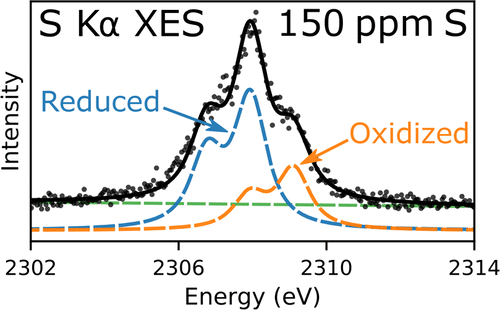当前位置:
X-MOL 学术
›
J. Phys. Chem. A
›
论文详情
Our official English website, www.x-mol.net, welcomes your
feedback! (Note: you will need to create a separate account there.)
Sulfur Speciation in Biochars by Very High Resolution Benchtop Kα X-ray Emission Spectroscopy
The Journal of Physical Chemistry A ( IF 2.7 ) Pub Date : 2018-05-21 00:00:00 , DOI: 10.1021/acs.jpca.8b02816 William M. Holden 1 , Gerald T. Seidler 1 , Singfoong Cheah 2
The Journal of Physical Chemistry A ( IF 2.7 ) Pub Date : 2018-05-21 00:00:00 , DOI: 10.1021/acs.jpca.8b02816 William M. Holden 1 , Gerald T. Seidler 1 , Singfoong Cheah 2
Affiliation

|
The analytical chemistry of sulfur-containing materials poses substantial technical challenges, especially due to the limitations of 33S NMR and the time-intensive preparations required for wet-chemistry analyses. A number of prior studies have found that synchrotron-based X-ray absorption near edge structure (XANES) measurements can give detailed speciation of sulfur chemistry in such cases. However, due to the obvious access limitations, synchrotron XANES of sulfur cannot be part of routine analytical practice across the chemical sciences community. Here, in a study of the sulfur chemistry in biochars, we compare and contrast the chemical inferences available from synchrotron XANES with that given by benchtop, extremely high resolution wavelength-dispersive X-ray fluorescence (WD-XRF) spectroscopy, also often called X-ray emission spectroscopy (XES). While the XANES spectra have higher total information content, often giving differentiation between different moieties having the same oxidation state, the lower sensitivity of the S Kα XES to coordination and local structure provides pragmatic benefit for the more limited goal of quantifying the S oxidation state distribution. Within that constrained metric, we find good agreement between the two methods. As the sulfur concentrations were as low as 150 ppm, these measurements provide proof-of-principle for characterization of the sulfur chemistry of biochars and potential applications to other areas such as soils, batteries, catalysts, and fossil fuels and their combustion products.
中文翻译:

超高分辨率台式KαX射线发射光谱分析生物炭中的硫形态
含硫材料的分析化学带来了重大的技术挑战,特别是由于33的局限性1 H NMR和湿化学分析所需的费时的准备工作。许多先前的研究发现,在这种情况下,基于同步加速器的X射线吸收法在边缘结构(XANES)的测量中可以给出详细的硫化学形态。但是,由于明显的访问限制,硫的同步加速器XANES不能成为整个化学科学界常规分析实践的一部分。在这里,在对生物炭中硫化学的研究中,我们将同步加速器XANES的化学推论与台式,极高分辨率的波长色散X射线荧光(WD-XRF)光谱(通常也称为X)给出的化学推论进行了比较和对比。射线发射光谱法(XES)。尽管XANES光谱的总信息量较高,通常,SKαXES对具有相同氧化态的不同部分进行区分,对配位和局部结构的较低敏感性为量化S氧化态分布的较有限目标提供了实用的好处。在该约束指标内,我们发现这两种方法之间有很好的一致性。由于硫的浓度低至150 ppm,因此这些测量为生物炭的硫化学特性表征以及在土壤,电池,催化剂,化石燃料及其燃烧产物等其他领域的潜在应用提供了原理证明。在该约束指标内,我们发现这两种方法之间有很好的一致性。由于硫的浓度低至150 ppm,因此这些测量为生物炭的硫化学特性表征以及在其他领域(例如土壤,电池,催化剂,化石燃料及其燃烧产物)的潜在应用提供了原理证明。在该约束指标内,我们发现这两种方法之间有很好的一致性。由于硫的浓度低至150 ppm,因此这些测量为生物炭的硫化学特性表征以及在土壤,电池,催化剂,化石燃料及其燃烧产物等其他领域的潜在应用提供了原理证明。
更新日期:2018-05-21
中文翻译:

超高分辨率台式KαX射线发射光谱分析生物炭中的硫形态
含硫材料的分析化学带来了重大的技术挑战,特别是由于33的局限性1 H NMR和湿化学分析所需的费时的准备工作。许多先前的研究发现,在这种情况下,基于同步加速器的X射线吸收法在边缘结构(XANES)的测量中可以给出详细的硫化学形态。但是,由于明显的访问限制,硫的同步加速器XANES不能成为整个化学科学界常规分析实践的一部分。在这里,在对生物炭中硫化学的研究中,我们将同步加速器XANES的化学推论与台式,极高分辨率的波长色散X射线荧光(WD-XRF)光谱(通常也称为X)给出的化学推论进行了比较和对比。射线发射光谱法(XES)。尽管XANES光谱的总信息量较高,通常,SKαXES对具有相同氧化态的不同部分进行区分,对配位和局部结构的较低敏感性为量化S氧化态分布的较有限目标提供了实用的好处。在该约束指标内,我们发现这两种方法之间有很好的一致性。由于硫的浓度低至150 ppm,因此这些测量为生物炭的硫化学特性表征以及在土壤,电池,催化剂,化石燃料及其燃烧产物等其他领域的潜在应用提供了原理证明。在该约束指标内,我们发现这两种方法之间有很好的一致性。由于硫的浓度低至150 ppm,因此这些测量为生物炭的硫化学特性表征以及在其他领域(例如土壤,电池,催化剂,化石燃料及其燃烧产物)的潜在应用提供了原理证明。在该约束指标内,我们发现这两种方法之间有很好的一致性。由于硫的浓度低至150 ppm,因此这些测量为生物炭的硫化学特性表征以及在土壤,电池,催化剂,化石燃料及其燃烧产物等其他领域的潜在应用提供了原理证明。











































 京公网安备 11010802027423号
京公网安备 11010802027423号